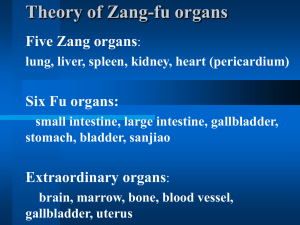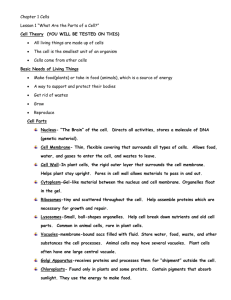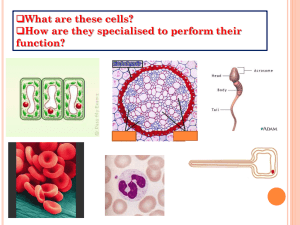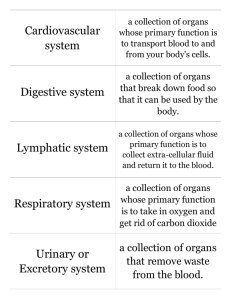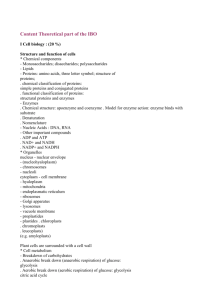What is human tissue?
advertisement
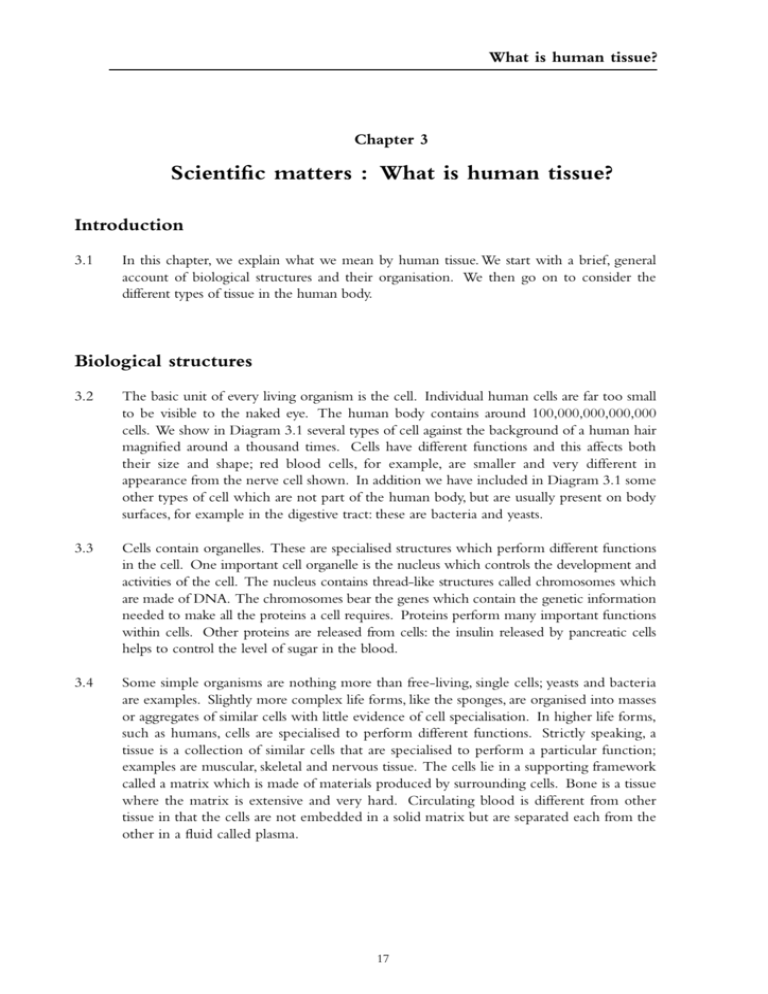
What is human tissue? Chapter 3 Scientific matters : What is human tissue? Introduction 3.1 In this chapter, we explain what we mean by human tissue. We start with a brief, general account of biological structures and their organisation. We then go on to consider the different types of tissue in the human body. Biological structures 3.2 The basic unit of every living organism is the cell. Individual human cells are far too small to be visible to the naked eye. The human body contains around 100,000,000,000,000 cells. We show in Diagram 3.1 several types of cell against the background of a human hair magnified around a thousand times. Cells have different functions and this affects both their size and shape; red blood cells, for example, are smaller and very different in appearance from the nerve cell shown. In addition we have included in Diagram 3.1 some other types of cell which are not part of the human body, but are usually present on body surfaces, for example in the digestive tract: these are bacteria and yeasts. 3.3 Cells contain organelles. These are specialised structures which perform different functions in the cell. One important cell organelle is the nucleus which controls the development and activities of the cell. The nucleus contains thread-like structures called chromosomes which are made of DNA. The chromosomes bear the genes which contain the genetic information needed to make all the proteins a cell requires. Proteins perform many important functions within cells. Other proteins are released from cells: the insulin released by pancreatic cells helps to control the level of sugar in the blood. 3.4 Some simple organisms are nothing more than free-living, single cells; yeasts and bacteria are examples. Slightly more complex life forms, like the sponges, are organised into masses or aggregates of similar cells with little evidence of cell specialisation. In higher life forms, such as humans, cells are specialised to perform different functions. Strictly speaking, a tissue is a collection of similar cells that are specialised to perform a particular function; examples are muscular, skeletal and nervous tissue. The cells lie in a supporting framework called a matrix which is made of materials produced by surrounding cells. Bone is a tissue where the matrix is extensive and very hard. Circulating blood is different from other tissue in that the cells are not embedded in a solid matrix but are separated each from the other in a fluid called plasma. 17 Scientific matters 3.5 Groups of different tissues can be organised further into complex organs like the liver, brain and kidneys, which perform specialised functions. The body’s organs are supported and covered by other tissue familiar to us as bone, muscle, connective tissue sheaths and skin. 3.6 In Diagram 3.2 we show a human liver at ever increasing magnifications from the whole organ down to an individual protein molecule. At each stage of the diagram a human structure with potentially valuable uses is shown. ៑ ៑ ៑ ៑ ៑ The whole liver, or part of it, may be used for transplantation. A section or block of the liver tissue may be used for research, for example to study how potential medicines affect the tissue. Liver cells may be maintained in culture and used for research, for example in looking at the toxicity of potential medicines. DNA can be extracted from the nucleus of a cell and may be used in testing for the presence of a gene defect associated with an illness. In the final part of the diagram, a protein molecule is being made. Some proteins, for example insulin and human growth hormone, are very valuable in the treatment of disease. Body wastes 3.7 In our report we have defined the body’s wastes as products that are ordinarily abandoned, such as urine, faeces, sweat, shorn hair, shed epithelial scales, nail clippings and the like. Hair, of course, although it is normally regarded as waste, may be sold for use in wigs. Some waste products may be made use of in medical treatment or research. Urine, for example, was used to isolate the substance erythropoietin, which stimulates the bone marrow to produce red blood cells (paragraph 5.5). Waste products, which are customarily discarded or abandoned, do not usually give rise to the ethical or legal considerations posed by the acquisition or use of the tissue or organs proper and we have excluded them from further consideration. 3.8 Unlike most of the waste products described above, the placenta is, of course, an example of a human tissue with a specialised function in the body. Once the placenta has completed its function and has been expelled from the body after birth, however, it is usually abandoned by mothers without more ado and is generally regarded as clinical waste and incinerated. Occasionally, however, the placenta may be used to extract proteins of therapeutic value, such as albumin which is used for treating burns. Some mothers may wish to ingest portions or infusions of the placenta in the belief that it wards off postnatal depression or is otherwise beneficial in the lying-in period. 18 What is human tissue? Conclusions 3.9 This report is concerned with human tissue organised at the different levels of complexity illustrated in Diagram 3.2. We offer, in Appendix 3, a survey of the many types of human tissue used therapeutically. A more general list of human tissue with uses discussed in this report would include: Organs and parts of organs Cells and tissue Sub-cellular structures and cell products Blood Gametes (sperm and ova) Embryos and fetal tissue 19 Scientific matters Diagram 3.1: An illustration of the relative sizes of different types of cell, shown against the background of a human hair (all structures are shown at a magnification of about ǂ1000). 20 What is human tissue? Diagram 3.2: A schematic view of the human liver, shown at progressively increasing magnifications, starting with the whole organ and ending with the DNA and proteins found in a single cell (approximate relative scales are indicated). 21
